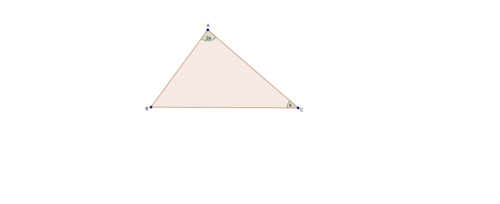New Year Fun !!!!!
 The sides of a triangle are
3
consecutive natural numbers & its largest angle is twice the smallest one. Determine the sum of the sides of the triangle.
The sides of a triangle are
3
consecutive natural numbers & its largest angle is twice the smallest one. Determine the sum of the sides of the triangle.
The answer is 15.
This section requires Javascript.
You are seeing this because something didn't load right. We suggest you, (a) try
refreshing the page, (b) enabling javascript if it is disabled on your browser and,
finally, (c)
loading the
non-javascript version of this page
. We're sorry about the hassle.
5 solutions
Awesome solution. I solved it the same way ^^.
Let the side opposite to (1) angle A (i.e 2a) be x+1 (2) angle C (i.e a) be x-1 (3) angle B be x Construct the internal bisector of angle A and let it intersect BC at D. Now, since angle CAD = angle ACB => AD=DC Now, in triangle ABC and DBA (1) angle DAB = angle ACB (2) angle ABC is common => triangle ABC is similar to triangle DBA.
→ A D A C = B D A B = A B B C o r D C a = B D a − 1 = a − 1 a + 1 = > D C + B D = a + 1 ( a ) ( a − 1 ) + ( a − 1 ) 2 = > a 2 − a + a 2 + 1 − 2 a = a 2 + 1 + 2 a = > a 2 − 5 a = 0 = > a = 5 Therefore sum of the sides of the triangle = 5 + (5-1) + (5+1) = 15
thank u.. ^_^
Actually i have already posted this problem - see click on this . The only thing that is modified is that this question asks for perimeter and mine asks for side.
oh.. so can u tell me the right answer..!!??? please ..!! with proper steps..!!
Let the triangle be ABC with largest angle A and smallest as C
Let the sides be x,x+1,x+2
The side BC=x+2, AB=x and AC=x+1
Let angle C =y
=> angle A=2y
Now,
construct a line CD such that it forms angle 'y' with AC and meets BA extended at D. By the exterior angle property in triangle CAD we have angle ADC=y
Now,
Apply similarity in triangles ABC and CBD and take the ratios excluding CD Form a Quadratic Equation and then SOLVE!!!!!!!!
Let the shortest side length of the triangle be x and the smallest angle be θ .
Then using Sine Rule, we have:
sin θ x = sin 2 θ x + 2 ⇒ x sin 2 θ = ( x + 2 ) sin θ
⇒ 2 x sin θ cos θ = ( x + 2 ) sin θ ⇒ 2 x cos θ = x + 2
⇒ cos θ = 2 x x + 2
Using Cosine Rule, we have:
x 2 = ( x + 1 ) 2 + ( x + 2 ) 2 − 2 ( x + 1 ) ( x + 2 ) cos θ
⇒ x 2 = ( x + 1 ) 2 + x 2 + 4 x + 4 − 2 x 2 ( x + 1 ) ( x + 2 ) 2
⇒ 0 = ( x + 1 ) 2 + 4 x + 4 − x ( x + 1 ) ( x + 2 ) 2
⇒ ( x + 1 ) 2 + 4 ( x + 1 ) = x ( x + 1 ) ( x + 2 ) 2
⇒ ( x + 1 ) + 4 = x ( x + 2 ) 2 ⇒ x ( x + 5 ) = ( x + 2 ) 2
⇒ x 2 + 5 x = x 2 + 4 x + 4 ⇒ x = 4
Therefore the sum of sides = x + ( x + 1 ) + ( x + 2 ) = 4 + 5 + 6 = 1 5